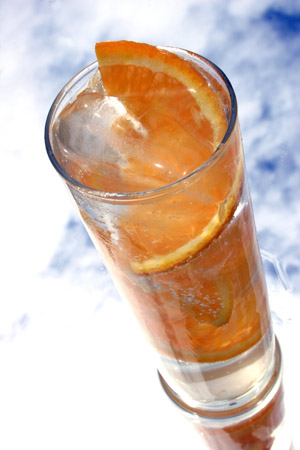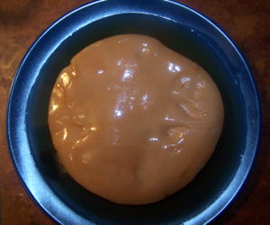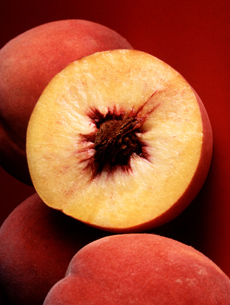 |

 |
Kombucha Wonder Drink gets our vote for the most
wondrous discovery of the year—although it’s been a West Coast cult favorite since 2001 (and the Chinese have been drinking kombucha since 221 B.C.E.). Shown above, Himalayan Blend with a twist of orange. |
| WHAT IT IS: Brewed, sweetened and fermented tea, drunk cold. |
| WHY IT’S DIFFERENT: Kombucha Wonder Drink has created a line of flavors infusing different teas—green, oolong and rooibos—with different fruit flavors, turning the traditional sweet-and-tart drink into a carnival of complex, adult tastes. |
| WHY WE LOVE IT: The matching of teas to fruits is inspired; the layers of flavors burst onto the palate in elaborate and unexpected ways. Kombucha Wonder Drink is not tea in any recognizable form, it’s not cider, it’s not a soft drink and it’s much more than plain kombucha. It’s an experience unto itself. |
| BUY IT AT: Find a store locator at WonderDrink.com. |
|
|
 |

Kombucha Wonder Drink: Elixir Of Life?
Page 3: The Kombucha “Mushroom” & The Health Benefits Of Kombucha
Click on the black links to visit other pages.
INDEX
MORE TO DISCOVEER
|
What Is Kombucha?
Kombucha is a fungus-like substance, a symbiotic colony of yeast and lactobacillus bacteria. Its first recorded use is said to have been during the Qin (Tsin) Dynasty of China (221 B.C.E.); one story says that it first fermented accidentally in the canteens of soldiers, who noted its restorative powers on the battlefield. The name comes from a Korean physician, Kom-bu, who introduced it to the Japanese Emperor Ingyo in the year 414 C.E. as a healing drink. It became known as tea of Kom-bu (Kombu-cha). It was introduced to the West via Russia, where it arrived before the Industrial Revolution, became very popular, and much later, in the 1990s, piqued the interest of the American future co-founder of Kombucha Wonder Drink, when the mother of a business colleague attributed her vitality to the beverage.
The Kombucha “Mushroom,” Or Starter
 The cultures used by Kombucha Wonder Drink come from Nepal, China and Siberia, some dating back thousands of years. In the “old country,” sharing kombucha cultures is a social activity: if someone needs a culture, you give him or her one of yours. In the U.S., kombucha cultures are grown commercially and purchased for home-brewing. The starter culture, or “mother,” is also referred to as a “mushroom,” for reasons evident in the photo at the right. Once one has a mushroom, it is self-replicating: each brewed batch of kombucha produces a new mushroom. The cultures used by Kombucha Wonder Drink come from Nepal, China and Siberia, some dating back thousands of years. In the “old country,” sharing kombucha cultures is a social activity: if someone needs a culture, you give him or her one of yours. In the U.S., kombucha cultures are grown commercially and purchased for home-brewing. The starter culture, or “mother,” is also referred to as a “mushroom,” for reasons evident in the photo at the right. Once one has a mushroom, it is self-replicating: each brewed batch of kombucha produces a new mushroom.
Photo courtesy of Wikipedia.
The Health Benefits Of Kombucha
When combined with brewed, sweetened tea and allowed to ferment, the culture produces the fizzy beverage. For centuries, people have thought kombucha to be a healthful, detoxifying tonic and a mild digestif. Others have ascribed to it greater powers: a cure for baldness, an antidote to high blood pressure, a cancer preventative and an all-around longevity aid. From a modern scientific standpoint, detoxifying benefits are believed to come from the glucuronic acid that is created during fermentation, not from the yeasts and bacteria in the culture. Thus, when the beverage is pasteurized (which is required by the F.D.A. for the commercial sale of packaged beverages) and the living organisms are killed, the purported benefit is not altered. However, neither theory has been proven through any clinical trial that has been published in any scientific journal. A toast of “to your health” with a glass of kombucha may have some teeth; how many teeth has yet to be seen.
Is kombucha an “elixir of life” or just a refreshing drink with some minor restorative properties, like coffee? If it depended on the popular vote, kombucha’s legions of fans in Asia, Russia and mainland Europe are now finding supporters across the U.S. Just be sure that when you cast your verbal vote, you pronounce it correctly—kom-BOO-cha, as in cha-cha—and gently refer those who insist on pronouncing it kom-boo-kah to the dictionary.
Continue To Page 4: A Recipe To Make Your Own Kombucha
Go To The Article Index Above
AUGUST IS NATIONAL PEACH MONTH

In China, the peach tree is considered to be the
tree of life, and peaches are symbols of
immortality.
|
|
FOR ADDITIONAL INFORMATION, special offers,
contests, opinion surveys, THE NIBBLETM
back issues archive, product gift-finder, links to our favorite
food websites, and the ability to nominate YOUR favorite nibbles,
visit www.TheNibble.com.
Do you have friends who would enjoy THE NIBBLE?
Click here to send them an invitation to sign up for their own copy. |
ABOUT THE NIBBLE™. THE NIBBLE™, Great Food Finds™, is an online magazine about specialty foods and the gourmet life. It is the only consumer publication and website that focuses on reviewing the best specialty foods and beverages, in every category. The magazine also covers tabletop items, gourmet housewares, and other areas of interest to people who love fine food.
© Copyright 2004-2025 Lifestyle Direct, Inc. All rights
reserved. All information contained herein is subject to change at any time
without notice. All details must be directly confirmed with manufacturers, service
establishments and other third parties. The material in this newsletter may not
be reproduced, distributed, transmitted, cached, or otherwise used, except with
the prior written permission of Lifestyle Direct, Inc.
|
 |
|
 |







